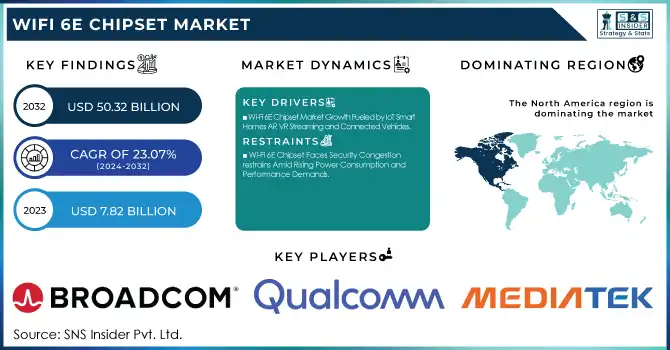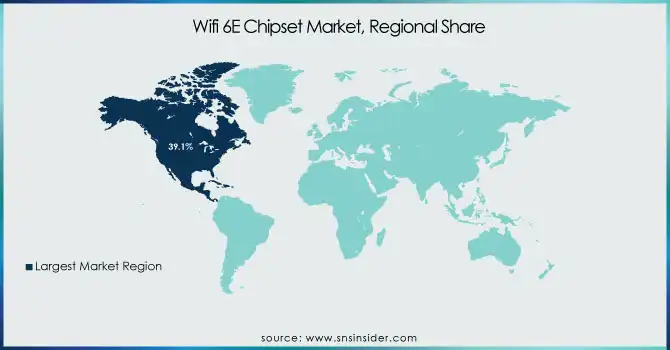Wifi 6E Chipset Market Size & Trends:
The Wifi 6E Chipset Market Size was valued at USD 7.82 billion in 2023 and is expected to reach USD 50.32 billion by 2032, growing at a CAGR of 23.07% over the forecast period 2024-2032. Wi-Fi 6E chipset is being rapidly adopted by enterprise networking, healthcare, industrial IoT, smart home, and automotive industries due to enhanced speed, low latency, and ability to handle high-bandwidth applications.

To Get more information on Wifi 6E Chipset Market - Request Free Sample Report
The high throughput, which reduces interference and increases energy efficiency, makes it great for streaming and gaming and tasks that require real-time communications, with improvements in reliability and performance over its predecessors. Sector-oriented use cases like connected cars, AR/VR, smart factories, etc., have begun paving the way towards innovation. Differences in the regulatory approvals for 6 GHz spectrum allocation across the regions may also affect deployment and the need to comply with several government policies and wireless standards.
Wifi 6E Chipset Market Dynamics
Key Drivers:
-
Wi-Fi 6E Chipset Market Growth Fueled by IoT Smart Homes AR VR Streaming and Connected Vehicles
High-speed, low-latency wireless connectivity-specific applications across industries are the key factors driving the Wi-Fi 6E chipset market. The continuation of IoT, smart homes, and industrial automation is driving Wi-Fi 6E-enabled devices, particularly in WLAN infrastructure, consumer electronics, and industrial IoT. After that, continuous growth of augmented reality (AR), virtual reality (VR), and 4K/8K streaming applications is driving demand for high-bandwidth wireless solutions. The huge automotive sector is one of the growth facilitators as connected vehicles and autonomous driving technology need data communication seamlessly so Wi-Fi 6E significantly drives the carrier for vehicle-to-everything communication by enabling high-speed concurrent data transmission.
Restrain:
-
Wi-Fi 6E Chipset Faces Security Congestion restrains Amid Rising Power Consumption and Performance Demands
The important restraint is the security and congestion issues over the network. With an increasing number of devices connecting on high-speed Wi-Fi networks, the risk of cyberattack, data breach, and unauthorized intrusion increases. Increased sophistication of cybersecurity risks and encryption protocols are also making mitigations complex, which is reflected in chipset design. Carrier-grade Wi-Fi and ultra-low-power performance will help extend the life of battery-powered applications (IoT and mobile devices) as Wi-Fi 6E devices have a much higher power consumption figure than previous generations. This challenge of balancing high performance with thermal efficiency and power optimization is a technical challenge that chipset vendors have to continuously solve through the rapid development of low-power solutions within their architectures.
Opportunity:
-
Wi-Fi 6E Market Expands with AI-Powered Networks Industrial Automation Healthcare and Growing 6 GHz Spectrum Availability
The market opportunities will be in the expansion of Wi-Fi 6E into new applications including drones, industrial automation, and healthcare. The rise in enterprise adoption of cloud computing and hybrid work models is also generating robust demand for Wi-Fi 6E-enabled enterprise networks. Additionally, the growing availability of the 6 GHz spectrum in several regions presents great opportunities moving forward. So, companies that are adopting tactics for AI-powered network optimization, power-efficient chipsets, and cyber-security solutions, all gain the upper hand in this continuously changing market.
Challenges:
-
Wi-Fi 6E Chipset Market Faces Challenges in Spectrum Regulation Regional Adoption Legacy Compatibility and Interference
Spectrum regulation & regional adoption hindrances are the key challenges for the Wi-Fi 6E Chipset Market. The 6 GHz band is key to Wi-Fi 6E performance but is geographically limited by regulatory constraints, resulting in a slow roll-out of global capacity. Another complication is that interference to incumbent technologies like satellite and licensed services in the 6 GHz band, must be mitigated to enable seamless deployment. Wi-Fi 6E will require substantial infrastructure updates to support it, creating an incompatibility between legacy Wi-Fi standards and devices that rely on it. The confluence of competing wireless standards for different use cases will necessitate this careful management of coexistence among standards in the enterprise and service provider spaces, with integrations and complexities around this nature becoming commonplace.
Wifi 6E Chipset Market Segment Analysis
By Device Type
In 2023, WLAN infrastructure devices accounted for 32.8% of the market share, driven by the expanding need for high-speed enterprise networking, cloud computing, and hybrid work solutions. Faster adoption of Wi-Fi 6E capable routers, access points, and gateways has also been fueled by smart home expansion, PoE-enabled IoT ecosystems, and the integration of 5G. As enterprises and telecom providers are upgrading their networks to accommodate high bandwidth, low latency, and high security, WLAN infrastructure serves as the first step in the larger journey of digital transformation.
Connected Vehicles are anticipated to exhibit the highest CAGR from 2024 to 2032, due to the growing autonomy in driving, vehicle-to-everything (V2X) communication, and in-car infotainment. With the ongoing implementation of real-time data exchange, AI-powered navigation, and smart traffic within vehicles, Wi-Fi 6E will enable ultra-fast, low-latency connectivity critical to enabling vehicles to communicate smoothly. The growing deployments of electric vehicles (EVs) and the software-defined vehicle architecture are driving the automotive industry for next-gen wireless solutions.
By End Use
The commercial segment held the largest market share of 30.6% in 2023, attributed to the increasing adoption of Wi-Fi 6E in enterprise, office, retail, and industrial infrastructures. Many businesses are refreshing their wireless infrastructure to support high-bandwidth, cloud-based applications, and remote work solutions. The growth of seamless connectivity in public spaces such as venues, stadiums, hotels, and smart city projects has also played a key role in its dominance. Another commercial environment that generates massive requirements for low-latency, high-speed networks for video conferencing, IoT integration, and security systems, needs Wi-Fi 6E to meet their business needs.
The residential/consumer segment is projected to witness the highest CAGR between 2024 and 2032, owing to increased penetration of smart homes, 4K/8K streaming, gaming, and IoT devices. A growing number of connected devices are coming online in every household, including gadgets that need an uninterrupted internet experience, such as laptops and even televisions, ultimately prompting the adoption of Wi-Fi 6E routers or mesh systems. Residential adoption is emerging as a key driver for growth in the Wi-Fi 6E market, further fueled by the rapid increase in remote work, online education, and continued growth in home automation.
Wifi 6E Chipset Market Regional Outlook
The North American region accounted for a WiFi 6E chipset market share of 39.1% in 2023 driven by early adoption of cutting-edge technologies across the region along with well-built network infrastructure coupled with large investments regarding IoT and smart homes. Wi-Fi 6E has been widely deployed in the U.S. in corporate and campus offices, and big venues such as stadiums, enabling people to stay connected and have a seamless digital experience. Big tech companies, including Cisco and Qualcomm, are leading the way in broadening Wi-Fi 6E solutions, facilitating advancements in smart city efforts and 5G convergence. Also, retailers such as Walmart leverage Wi-Fi 6E at scale for managing and analyzing stock levels and customer behaviors/experiences to make real-time decisions.
The Asia-Pacific region will witness the fastest CAGR during the forecast period of 2024-2032 owing to the growing digital infrastructure, increase in the adoption of consumer electronics, and the initiative by the governments to develop smart cities. Leading countries such as China, Japan, and South Korea are harnessing Wi-Fi 6E capabilities for their smart manufacturing, autonomous vehicles, and telemedicine initiatives. As an instance, Shenzhen city in China is adopting public Wi-Fi networks powered by Wi-Fi 6E as part of its smart city initiatives. On the other hand, KT Corporation in South Korea leverages Wi-Fi 6E for high-density locations including airports and shopping malls, providing better seamless connectivity for millions of customers. The demand is also fueled by rapid urbanization in the region and the increasing penetration of smartphones.

Get Customized Report as per Your Business Requirement - Enquiry Now
Key Players
Some of the major players in the Wifi 6E Chipset Market are:
-
Broadcom Inc. (BCM4389 Wi-Fi 6E/Bluetooth Combo Chipset, BCM4385 Wi-Fi 6E SoC)
-
Qualcomm Technologies, Inc. (FastConnect 6900, Networking Pro 1610)
-
Intel Corporation (Intel Wi-Fi 6E AX210, Intel Wi-Fi 6E AX211)
-
MediaTek Inc. (MT7921K Wi-Fi 6E Module, Filogic 830 Wi-Fi 6E Platform)
-
NXP Semiconductors N.V. (IW612 Tri-Band Wi-Fi 6E/Bluetooth 5.2 Solution, IW611 Wi-Fi 6E Solution)
-
ON Semiconductor Connectivity Solutions, Inc. (QCS-AX2 Wi-Fi 6E Chipset, QCS-AX1 Wi-Fi 6E Chipset)
-
Renesas Electronics Corp. (RZ/G2L Wi-Fi 6E Solution, RZ/A3UL Wi-Fi 6E Module)
-
Texas Instruments Inc. (SimpleLink™ CC3300 Wi-Fi 6E Module, WiLink™ 8 Wi-Fi 6E Solution)
-
Infineon Technologies AG (AIROC™ CYW55573 Wi-Fi 6E/Bluetooth Combo, AIROC™ CYW89570 Wi-Fi 6E Solution)
-
STMicroelectronics N.V. (STM32WB5MMG Wi-Fi 6E Module, STM32WL5x Wi-Fi 6E Solution)
-
Marvell Technology Group Ltd. (88W9098 Wi-Fi 6E SoC, 88Q9098 Automotive Wi-Fi 6E Solution)
-
Realtek Semiconductor Corp. (RTL8852AE Wi-Fi 6E Module, RTL8852BE Wi-Fi 6E Solution)
Recent Trends
-
In November 2024, Qualcomm introduced the QCC730M, a micro-powered Wi-Fi 4 module, and the QCC74xM, its first programmable RISC-V-based connectivity module, enhancing IoT efficiency and versatility.
-
In January 2024, Intel's latest mobile and desktop CPUs, including the Core i9-14900HX, feature Wi-Fi 6E (Gig+) for faster, more reliable wireless connectivity.
| Report Attributes | Details |
|---|---|
| Market Size in 2023 | USD 7.82 Billion |
| Market Size by 2032 | USD 50.32 Billion |
| CAGR | CAGR of 23.07% From 2024 to 2032 |
| Base Year | 2023 |
| Forecast Period | 2024-2032 |
| Historical Data | 2020-2022 |
| Report Scope & Coverage | Market Size, Segments Analysis, Competitive Landscape, Regional Analysis, DROC & SWOT Analysis, Forecast Outlook |
| Key Segments | • By Device Type (WLAN Infrastructure Devices, Consumer Devices, Wireless Cameras, Industrial IoT Devices, Connected Vehicles, Drones, Others) • By End Use (Residential/Consumers, Commercial, Industrial, Smart City, Transportation & Logistics, Government & Defense, Others) |
| Regional Analysis/Coverage | North America (US, Canada, Mexico), Europe (Eastern Europe [Poland, Romania, Hungary, Turkey, Rest of Eastern Europe] Western Europe] Germany, France, UK, Italy, Spain, Netherlands, Switzerland, Austria, Rest of Western Europe]), Asia Pacific (China, India, Japan, South Korea, Vietnam, Singapore, Australia, Rest of Asia Pacific), Middle East & Africa (Middle East [UAE, Egypt, Saudi Arabia, Qatar, Rest of Middle East], Africa [Nigeria, South Africa, Rest of Africa], Latin America (Brazil, Argentina, Colombia, Rest of Latin America) |
| Company Profiles | Broadcom Inc., Qualcomm Technologies, Inc., Intel Corporation, MediaTek Inc., NXP Semiconductors N.V., ON Semiconductor Connectivity Solutions, Inc., Renesas Electronics Corp., Texas Instruments Inc., Infineon Technologies AG, STMicroelectronics N.V., Marvell Technology Group Ltd., Realtek Semiconductor Corp. |

